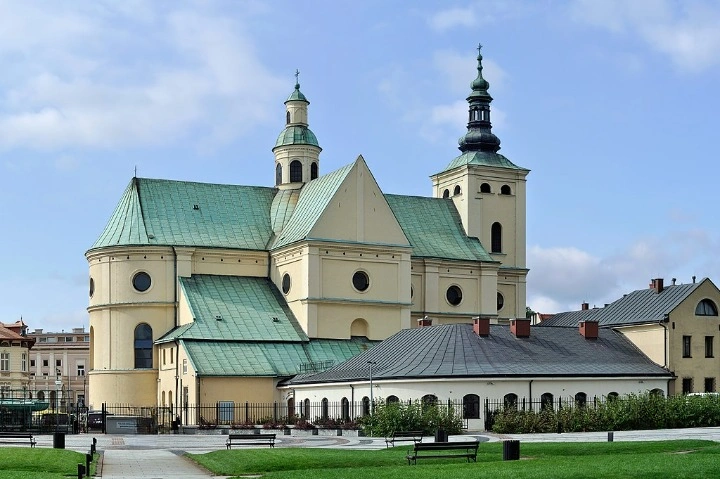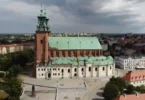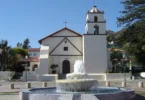Introduction
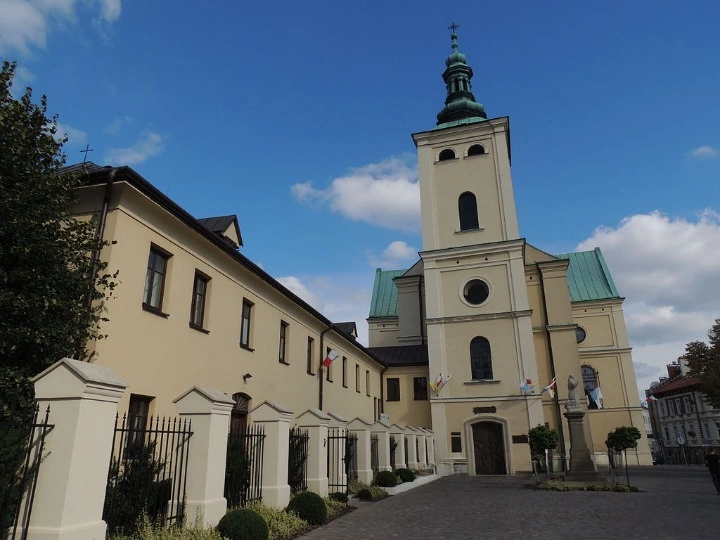
The Basilica of the Assumption of the Blessed Virgin Mary is the name of a few old and important churches in Poland, all connected by their dedication to Mary. One of the most well-known is the beautiful Baroque church in Krzeszów, built in the early 1700s. It is regarded as a significant religious site in Lower Silesia and is a component of a Benedictine abbey. The second one is in Rzeszów, right in the middle of the city. It was built in 1629 and is next to a Bernardine monastery. Additionally, it is a well-known Marian shrine. There’s also another parish church in Rzeszów, built earlier between 1610 and 1629, but officially made a parish in 1970. It’s located on Sokoła Street and has been a part of local religious life for generations.
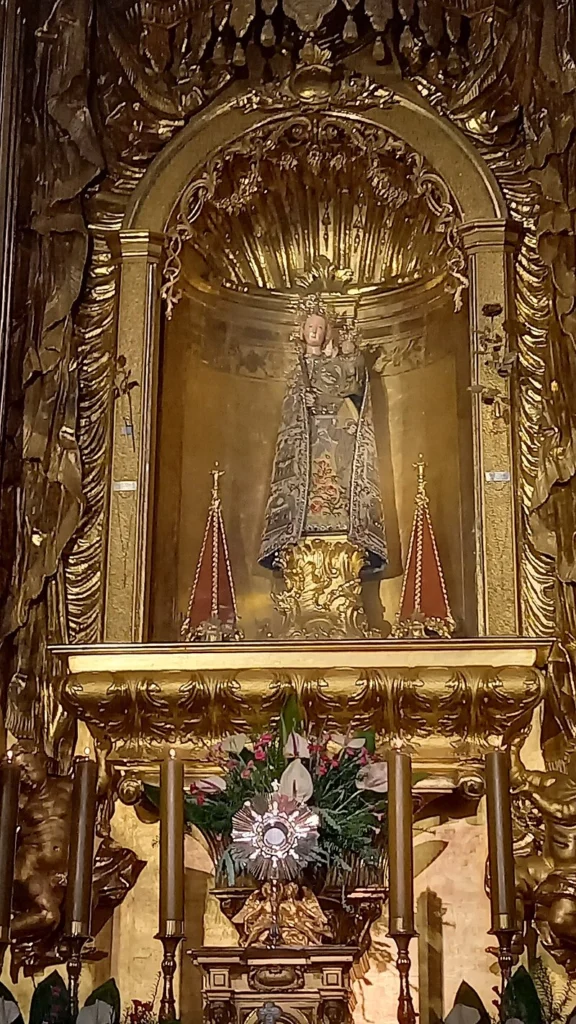
Church of the Blessed Virgin Mary in Wola Stara
In 1475, the parish priest of Rzeszów received a house with a garden and an orchard in Wolica (Wola Stara), which was then a suburb of Rzeszów at the entrance to the Kraków route, from the city’s heir, the Rzeszowski family. The “Blessed Virgin Mary” (ex opposito beate Virginis Mariae) was directly in front of this estate. Scholars refer to a wooden church that was dedicated to the Blessed Virgin Mary. Before Mikoaj Spytek Ligza built a brick church on this site, which was later given to the Bernardine Order, this church was there. In the 15th century, Wola Stara belonged to the parish parish in Rzeszów . Waidysaw Hennig claims that the three bodies discovered in the church’s exterior wall near the entrance in August 2001 at a height of 3 meters may have been from the first church’s medieval cemetery.
Legend
An account of an apparition that is believed to have occurred prior to the establishment of the Bernardine monastery in Rzeszów is included in the chronicle of the monastery, which cannot have been written prior to the 17th century. Interestingly, the story claims the wooden chapel wasn’t built until after 1513, though that date might not be entirely accurate. It tells of a man named Jakub Ada, a poor but virtuous peasant, who lived near what is now the site of the Bernardine church. Jakub was strolling through his orchard on the evening of August 15, 1513, the Feast of the Assumption, when he noticed a strange light surrounding a pear tree. The leaves rustled, and as he got closer, he heard a voice say: “Do not be afraid. I want the glory of my Son to be seen in this place and to bring comfort to the suffering.” It appears that others in the vicinity also heard the voice because it was so loud. Jakub told his neighbors what he’d seen and heard, and when they all came running, they noticed something remarkable a wooden statue of the Virgin Mary holding the baby Jesus in her left arm and a royal scepter in her right, resting on the pear tree itself. This event, recorded in “The Story of the Appearance of the Statue…” (Rzeszów, 1765) is both a local devotion and a legend. Later, historians like Jan Pęckowski tried to link Jakub Ada with the Dada family a bourgeois family mentioned in 17th-century Rzeszów records. It is believed that Ada initiated the construction of a modest wooden church and a small chapel between 1531 and 1536 to house the pear-carved statue. The church, dedicated to the Dormition and Assumption of the Virgin Mary, even had a defensive character, which wasn’t uncommon at the time. As for the statue itself Władysław Hennig noted that it’s likely older than the story claims. Carved in the late Gothic style, the Madonna’s figure probably dates from the 15th century, which puts it decades before the alleged apparition.
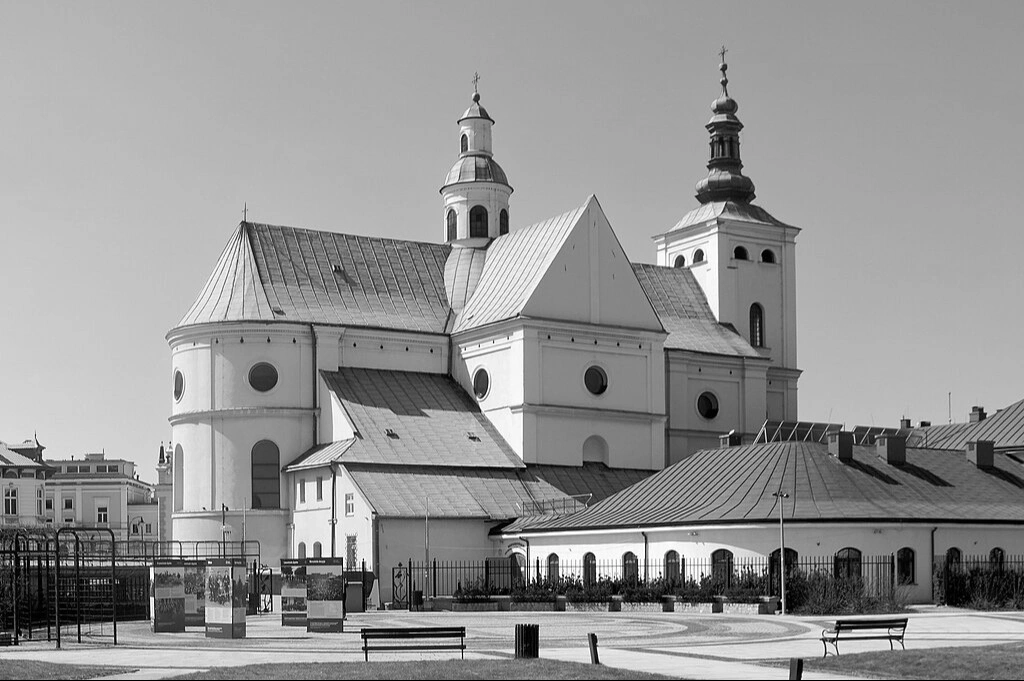
Foundation
Through his marriage to Elbieta Rzeszowska (née Kormanicka) in 1584, Mikoaj Spytek Ligza acquired Rzeszów. Before 1603 he moved his seat from the Old Town to the fortified manor house in Staroniwa Dolna (later Rzeszów Castle ), which he transformed around 1620 into a quadrangular palazzo in fortezza style , and in 1624 fortified with an earth rampart. In the 1620s, these ramparts were constructed all the way around Rzeszów. As part of the city’s defenses, Ligza probably decided to build a new church in Wola Stara. The first evidence that Ligza acquired land for a new church can be found in 1618. After receiving the title of Castellan of Sandomierz in 1619, Ligęza purchased and relocated Wola Stara, with which the wooden Church of the Blessed Virgin Mary was associated, in the years 1621–1627 for the construction of Rzeszów’s fortifications.Lake Bernardyskie, which was created in the foreground of the fortifications, flooded the village area. Therefore, the date of 1624 is more likely rather than the sometimes-cited 1610 for the start of the church’s construction. The construction was overseen by architects probably from Leipzig. The church was planned as a family mausoleum for the Ligęza family. Like the Small Synagogue or the castle , which was expanded at the time, it became part of the city’s new fortification system. From a hill surrounded by an artificial lake, in the immediate vicinity of the Mikośka stream , it served as an advanced corner fort, flanking the Brick Gate from the west, which received traffic towards the city from the north, east, and west. It provided shelter for civilians in case of danger, and its tower was equipped with embrasures. A sluice was also included to regulate the lake’s level, which fed the castle moat. After dedicating the church to “the Most Holy Blessed Virgin Mary, my Patroness,” Ligza brought the Bernardine brothers to Rzeszów and gave them the building in 1629. The main goal of the Bernardines, who were brought to the eastern part of the Polish-Lithuanian Commonwealth, was to convert the Orthodox inhabitants of these areas to Catholicism and to renew the religious life of the local population. Leajsk, Radecznica, and Lviv were the most important Marian sanctuaries run by this order in its Ruthenian province. Of the approximately 170 Bernardine centers in Poland, as many as 50 were dedicated to Marian devotion. The Rzeszów center stood out as a Passion sanctuary.
Century: 17th and 18th
On March 25, 1629, the monastery was handed over to the Bernardines. MS Ligza and his wife Zofia de’ Rzeszowska, as well as the provincial, were in attendance at the ceremony. Fr. Michał Heller, and three brothers who took up permanent residence in Rzeszów. The monastery was soon expanded and more monks were brought in. In accordance with his wishes, Ligza was buried at the church’s threshold when he passed away in 1637. Jerzy Sebastian Lubomirski, his son-in-law, and his daughter Konstancja continued to manage the monastery. The Rzeszów cult center gained a reputation among the community as a place of miracles over time. The Lubomirski family, which wore the “Dzina” coat of arms, reportedly underwent miracles, according to monastery records (Jerzy, who was saved from death by a gunshot wound, and Teodor, who had fallen seriously ill as a child). Representatives of this royal family began pursuing the miraculous statue’s coronation as a token of appreciation. The consent for the coronation was given by Benedict XIV , and it was performed on September 8, 1763 (already during the pontificate of Clement XIII ) by the Metropolitan of Lviv Wacław Hieronim Sierakowski , the crown was funded by Jerzy Ignacy Lubomirski
Austrian partition
When, in 1787, during the partition period, the authorities issued an order to suppress one of Rzeszów’s mendicant orders , Bishop Antoni Gołaszewski of Przemyśl decided to hand over the Reformed buildings, stating that the Bernardines were “more useful to the city”. Almost from the beginning of their presence in the city, the Bernardines ran a soup kitchen for the poor, a guesthouse for pilgrims, and cultivated approximately 15 hectares of land. Seedlings of flowers, fruits, and vegetables were also traded. In 1863, the centenary celebration of the coronation of the image of the Virgin Mary attracted 100,000 faithful, mainly from Galicia . Three years later, the crowns were stolen. A new coronation was held in 1896 by Vilnius’s Metropolitan Karol Hryniewiecki, and it was attended by 60,000 devotees. In 1913 , the 400th anniversary of the apparitions was celebrated.
World War II
After the German army captured Rzeszów on 9 September 1939, a field gendarmerie unit of about a dozen men, commanded by Captain Schiffko, was stationed in the monastery buildings . A firing squad of gendarmes led by his deputy, Lieutenant Liszka or Pliszka from Berlin, shot about 40 people from the Castle prison in the Bernardine Gardens beginning in the second half of September. The victims, according to Franciszek Kotula’s war diaries, were men who were killed for having weapons. Around the turn of October and November 1939, the gendarmerie was supposed to leave Rzeszów, to be replaced by Captain Steinmetz’s Schupo battalion, which operated, among other offices, at the Bank Gospodarstwa Krajowego at 2 Bernardyńska Street. Kotula, however, noted that on November 20, 1939, Henryk Durda, a pre-war instructor of the Riflemen’s Association and a teacher from Głogów Małopolski, was shot in the Bernardine Gardens after returning from the East. Similar to Kotula, the Polish Black Book states that the victims were forced to dig their own graves and attribute the execution to the Gestapo.
Architecture of Basilica of the Assumption of the Blessed Virgin Mary, Rzeszów, Poland
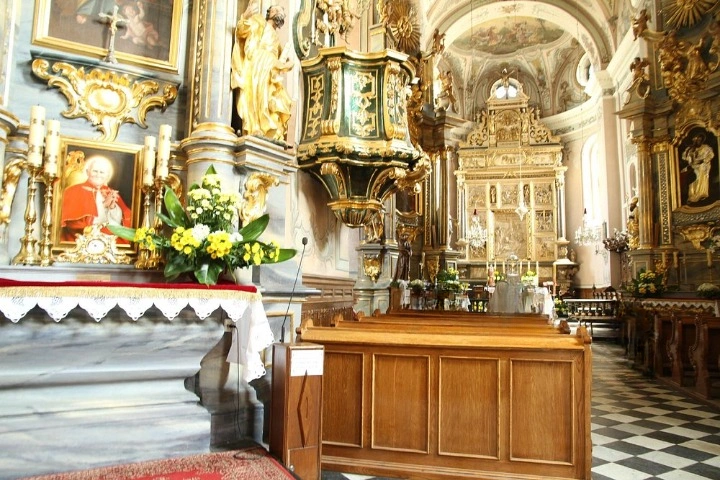
The Bernardine Church in Rzeszów was built between 1624 and 1629 in a late Renaissance, Mannerist , or early Baroque style , difficult to classify unequivocally . The founder, Mikołaj Spytek Ligęza, described it in the foundation document of March 25, 1629, as a “cross church” with “bulbous chapels,” suggesting the original existence of domed vaults. The building’s architectural and artistic aspects exhibit a harmonious blend of Renaissance and early Baroque styles, as well as very elaborate Rococo-style decorations.
Chapels
The interior of the chapel, which houses the statue of Mary and Child, dates from the first half of the 18th century. It was founded by Jerzy Ignacy Lubomirski. The statue occupies the center of a Baroque altar crafted from wood and covered with gilding. Paintings in the shape of medallions depict scenes from Our Lady’s life (the Annunciation, the Visitation of St. Elizabeth, the Birth of Christ, the Presentation in the Temple, and the Assumption of Mary). The altar is topped by an oval painting of Our Lady Immaculate. Two angels support it, and the Holy Spirit and God the Father hover above it. On the walls of the chapel, votive paintings depict blessings received through Our Lady of Rzeszów’s intercession.
Presbytery
In the chancel, the tombstones of members of the Ligęza family, attributed to Sebastian Sala and dating from before 1637, are particularly noteworthy and form the family mausoleum. These life-size sculptures depict eight of the family’s most prominent figures in the oratory position. The figures are made of alabaster and incorporated into the north and south walls of the chancel. Each figure faces the altar. Seven of them are dressed in knightly attire, while the bishop’s figure is in pontifical robes. They constitute the largest collection of oratory sculptures made of alabaster in Europe. Below the monumental niches, marble tablets with obituary-style texts have been built into the north wall. On the north wall, we can see Mikołaj Ligęza , the founder’s father and the Castellan of Wiślica; Zygmunt Ligęza, Grand Crown Cup-Bearer; Stanisław Ligęza, castellan of Żarnowiec and starost of Lubaczów, as well as the church’s founder, Mikołaj Ligęza of Bobrek. The southern wall of the chancel depicts Hermolaus Ligęza , Grand Treasurer of the Crown ; Jan Ligęza , Voivode of Łęczyca; Feliks Ligęza , Archbishop of Lviv ; and probably Jan Ligęza, son of Jan, Voivode of Łęczyca. The church’s chancel is occupied by monastic stalls placed along the walls on the left and right. They were crafted from oak and designed by Zygmunt Hendel of Krakow. The stalls consist of seven box-shaped seats with high backrests and a narrow canopy. The entire structure is richly carved. Decorative motifs evoke the Baroque and Regency styles. A wooden baptismal font with Baroque formal features characteristic of the 17th century was also placed in the chancel. It has the form of a chalice with a cover topped with an ornament composed of acanthus leaves and an inverted pine cone.
Feast Day
Feast Day : 15 August
The Basilica of the Assumption of the Blessed Virgin Mary in Rzeszów, Poland, celebrates its main feast day on August 15th. This is the Feast of the Assumption of the Blessed Virgin Mary, a special day that holds great meaning for the church and its community.
Church Mass Timing
Monday to Saturday : 6:00 AM , 7:00 AM , 8:00 AM , 9:00 AM , 6:00 PM
Sunday : 6:00 AM , 7:30 AM , 9:00 AM , 10:30 AM , 12:00 PM , 3:00 PM , 4:30 PM , 6:30 PM
Church Opening Time:
Monday to Saturday : 5:30 AM, 7:00 PM
Sunday : 5:30 AM, 7:30 PM
Contact Info
Address : Basilica of the Assumption of the Blessed Virgin Mary
Sokoła 8, 35-010 Rzeszów, Poland
Phone : +48 17 853 34 95
Accommodations
Connectivities
Airway
Basilica of the Assumption of the Blessed Virgin Mary, Rzeszów, Poland to Rzeszów-Jasionka Airport, distance between 18min (11.9 km) via DW878.
Railway
Basilica of the Assumption of the Blessed Virgin Mary, Rzeszów, Poland to Rzeszów Główny Railway Station, distance between 4m (850 m)via Jana III Sobieskiego.

